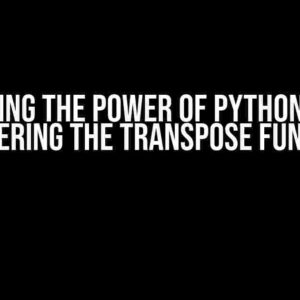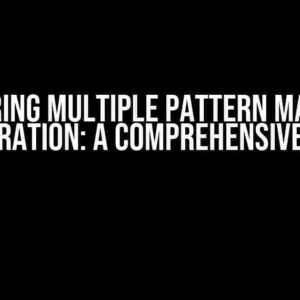Are you tired of wrestling with scoped variables and namespace changes in your programming adventures? Worry no more, dear developer! In this epic article, we’ll delve into the fascinating world of global namespaces, exploring how they change depending on scope. Buckle up, and let’s get started!
What is a Global Namespace?
A global namespace, in the realm of programming, refers to the top-level scope of a program. It’s the pinnacle of the scope hierarchy, where variables, functions, and objects reside. Think of it as the “root” of your program’s scope tree. The global namespace is where you declare your variables, define your functions, and create your objects, making them accessible from anywhere in your code.
Scope: The Game-Changer
Scope, in the context of programming, refers to the region of the code where a variable, function, or object is defined and accessible.Scope determines the visibility and lifespan of an identifier (variable, function, or object). In other words, scope defines where an identifier can be used and how long it remains in memory.
Now, here’s the twist: when you create a new scope, such as a function or a block, the global namespace changes. But why? Let’s dive deeper into the magic of scope and namespace changes.
Scope and Namespace Changes: The Dynamic Duo
In programming, when you create a new scope, the global namespace is temporarily altered. This means that the set of identifiers (variables, functions, and objects) available in the global namespace changes. The new scope introduces its own set of identifiers, which might shadow or override the ones in the global namespace.
Shadowing: The Sneaky Namespace Change
Shadowing occurs when a new identifier in a local scope has the same name as an identifier in the global namespace. In this case, the local identifier takes precedence, and the global identifier becomes inaccessible within that scope. This is known as shadowing, where the local identifier “shadows” the global one.
// Global namespace
var globalVar = 10;
function myFunction() {
// Local scope
var globalVar = 20; // Shadows the global variable
console.log(globalVar); // Output: 20
}
In the example above, the `globalVar` variable is declared in the global namespace and assigned the value 10. Within the `myFunction` scope, a new `globalVar` variable is declared and assigned the value 20. When we log `globalVar` within the function, it outputs 20, demonstrating how the local variable shadows the global one.
Overrides: The Namespace Changer
Overrides occur when a new identifier in a local scope has the same name as an identifier in the global namespace, and the local identifier redefines the global one. This means that the global identifier is no longer accessible, and the local identifier takes its place.
// Global namespace
function globalFunction() {
console.log("Global function");
}
function myFunction() {
// Local scope
function globalFunction() { // Overrides the global function
console.log("Local function");
}
globalFunction(); // Output: Local function
}
In the example above, the `globalFunction` function is declared in the global namespace. Within the `myFunction` scope, a new `globalFunction` function is declared, overriding the global one. When we call `globalFunction` within the `myFunction` scope, it outputs “Local function”, demonstrating how the local function overrides the global one.
Understanding Scope Chain and Namespace Changes
A scope chain is a fundamental concept in programming, referring to the sequence of scopes that are searched to resolve an identifier. The scope chain determines the order in which scopes are searched to find an identifier. When a new scope is created, the scope chain is updated, and the global namespace changes accordingly.
Let’s explore an example to illustrate the scope chain and namespace changes:
// Global namespace
var globalVar = 10;
function outerFunction() {
// Outer scope
var outerVar = 20;
function innerFunction() {
// Inner scope
var innerVar = 30;
console.log(innerVar); // Output: 30
console.log(outerVar); // Output: 20
console.log(globalVar); // Output: 10
}
}
In the example above, we have three scopes: global, outer, and inner. Each scope has its own set of identifiers (variables). When we log the variables within the inner scope, the scope chain is searched in the following order:
- Inner scope: `innerVar` is found, and its value is logged.
- Outer scope: `outerVar` is found, and its value is logged.
- Global namespace: `globalVar` is found, and its value is logged.
The scope chain is traversed in this order because each scope is nested within the previous one. The inner scope is nested within the outer scope, which is nested within the global scope. This is why the identifiers are resolved in this particular order.
Best Practices for Managing Namespace Changes
To avoid confusion and ensure maintainable code, follow these best practices for managing namespace changes:
- Use unique identifiers**: Avoid using the same identifier names in different scopes to prevent shadowing and overrides.
- Use scope-specific naming conventions**: Use prefixes or suffixes to differentiate between identifiers in different scopes.
- Avoid global variables**: Minimize the use of global variables, and instead, use local variables or properties to reduce namespace pollution.
- Use modular programming**: Break down your code into smaller, self-contained modules to reduce the risk of namespace conflicts.
- Use a linter or code analyzer**: Utilize tools that can detect and warn about potential namespace issues.
By following these best practices, you’ll be well-equipped to manage namespace changes and write more maintainable, efficient code.
Conclusion
In conclusion, understanding global namespace changes depending on scope is crucial for any programmer. By grasping the concepts of scope, shadowing, overrides, and scope chains, you’ll be better equipped to manage namespace changes and write more robust, maintainable code.
Remember, the global namespace is not a fixed entity; it dynamically changes depending on the scope. By using unique identifiers, following scope-specific naming conventions, and minimizing global variables, you can ensure a smooth and efficient coding experience.
| Scope | Namespace Change |
|---|---|
| Global | No change |
| Local (function/block) | Shadowing or override |
| Nested scope | Scope chain update |
With this comprehensive guide, you’re now ready to tackle the challenges of global namespace changes depending on scope. Happy coding!
Frequently Asked Question
Get the scoop on global namespace changes depending on scope!
What is a global namespace?
A global namespace is a scope that is accessible from anywhere in the program. It’s like the ultimate VIP pass that gives you access to all the variables, functions, and objects in your code!
How does the global namespace change depending on scope?
When you define a variable or function inside a scope (like a function or block), it creates a new namespace that shadows the global namespace. This means that the global namespace is temporarily replaced by the local namespace, and any changes made to variables or functions within that scope won’t affect the global namespace.
Can I access the global namespace from within a local scope?
Yes, you can! In most programming languages, you can use the global keyword or a similar mechanism to access the global namespace from within a local scope. This allows you to modify or use global variables and functions even when you’re inside a local scope.
What happens if I declare a variable with the same name in a local scope?
When you declare a variable with the same name in a local scope, it shadows the global variable with the same name. This means that the local variable takes precedence over the global variable, and any changes you make to the local variable won’t affect the global variable.
Why is it important to understand global namespace changes depending on scope?
Understanding how the global namespace changes depending on scope is crucial for writing efficient, bug-free, and maintainable code. It helps you avoid naming conflicts, unexpected behavior, and ensures that your code works as intended. Plus, it makes you a rockstar developer!






